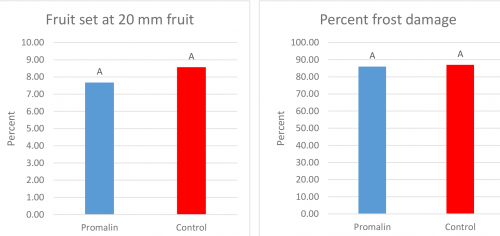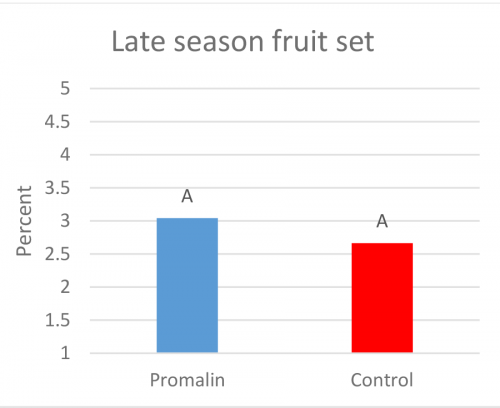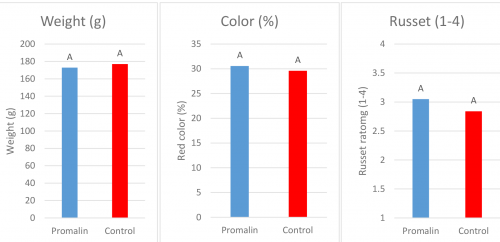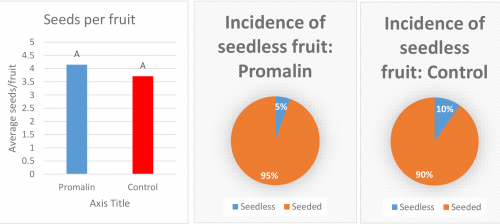How did SweeTango and Red Delicious apples respond to Promalin after the 2017 spring frost?
Results of a common post-freeze practice on commercial SweeTango and Red Delicious apples in 2017.
Promalin, manufactured by Valent BioSciences, is commonly used by apple growers after freeze events that occur during bloom to promote fruit set from damaged flower tissue that would not otherwise survive to set a crop. This product contains two distinct gibberellic acids, GA-4 and GA-7, as well as a cytokinin, 6-Benzyladenine. These three plant growth hormones are designed to promote various elements of cellular division in plant tissues, leading to higher survivorship of freeze-damaged blossoms.
While this product has been on the market for over 20 years, the unpredictable nature of spring freezes makes replicable study on the outcomes of this product difficult. As a result, we have only scattered experiences as an industry in understanding how this product behaves on specific apple varieties, and what degree growers can expect to see benefit based on the severity of the freeze event.
Following the freeze events during bloom on May 8 and 9, 2017, this product was used by many Michigan growers in efforts to combat damage to the apple crop. Following these applications, four apple varieties at commercial sites in west central Michigan were followed through the growing season and compared with controls at the same locations to measure effects on fruit set, diameter, mass, color, russet, seed count, average seed number and incidence of parthenocarpic fruit. Rome, Idared, Red Delicious and SweeTango were the selected varieties.
This three-part Michigan State University Extension article series summarizes the results for the varieties, in addition to a brief synopsis of the environmental conditions during and immediately after the freeze events. To read the summaries of the other varieties tested, see “How did Rome apples respond to Promalin after the 2017 spring frost?” and “How did Idared apples respond to Promalin after the 2017 spring frost?”
Red Delicious
On May 8, the nearest MSU Enviroweather station to this site recorded 8 hours below freezing with a minimum temperature of 23.2 degrees Fahrenheit. On May 9, another 5 hours below freezing was recorded with a minimum temperature of 26.8 F. Promalin was applied at the site at pint per acre in the morning on May 10. Following the application, daily high temperatures rose to 68.4 F on May 10, 70.3 F on May 11 and 68.7 F on May 12.
One hundred percent of control and 90.5 percent of Promalin-treated blossoms were damaged on Red Delicious at this site. No fruit set at the site in either the control or treatment groups. In this situation, the level of damage on this variety was likely too great for Promalin to have any effect. No product can save a flower that has been killed outright by a frost, and always keep this in mind if freeze events are severe.
SweeTango
The same MSU Enviroweather station applied to the SweeTango site; on May 8, we recorded 8 hours below freezing with a minimum temperature of 23.2 F. On May 9, another 5 hours below freezing was recorded with a minimum temperature of 26.8 F. Promalin was applied at pint per acre in the morning on May 10. Following the application, daily high temperatures rose to 68.4 F on May 10, 70.3 F on May 11 and 68.7 F on May 12.

Figure 1: Fruit set (total flowers divided by counted fruitlets after bloom) and percent frost damage to flowers.
There was no statistical difference in fruit set at 20 millimeter fruit, but the control group (8.6 percent) showed a slightly higher percentage of successful fruit set than the Promalin treated group (7.8 percent). Frost damage was the same across treatment trees.

Figure 2. Late season fruit set (total set fruits on measurement branch divided by initial number of flowers). Independent t-test, p>0.05.
In spite of having slightly higher fruit set at 20 millimeter fruit, the control group fell below the Promalin group in fruit set by late July. While the difference was not significant, it matched the results seen in Idared and Rome with a small numerical increase in fruit set. However, the observed increase on SweeTango was less than 1 percent and cannot be considered significant.

Figure 3. Weight (g), color (%) and russet rating at harvest for control and treatment groups. Weight, color, and russet: independent t-test, p>0.5.
No difference in the weight, color or incidence of russet was recorded between SweeTango treatments. While very slight numerical differences were measured, difference were not statistically significant.

Figure 4. Average seeds per fruit and incidence of parthenocarpic fruit in control and treatment groups. Seeds per fruit: independent t-test, p>0.05.
No significant difference in average seeds per fruit was recorded between control and treatment groups. Promalin-treated fruits had slightly more seeds per fruit numerically, but the difference was not significant. Incidence of seedless fruit was higher by 5 percent in the control group than the Promalin treatment group.
Summary
The results for Red Delicious and SweeTango highlight one of the chief grower frustrations with using this product in a challenging year: Achieving positive results are not always certain and can be difficult to quantify. There were no measurable differences in any major fruit quality or yield category in this particular trial for SweeTango, and applying it made no difference, numerical or statistical, at our trial site on Red Delicious.
While Promalin remains an important tool for farmers to consider in post-frost situations and has been demonstrated to help alleviate frost damage in many situations, there are many considerations that factor into the decision to use it. Is the apple variety high in value? Is the possibility of a potentially small yield increase worth trying for based on the cost of the product and potential return? Are all of the blossoms dead prior to the application? Can you rely the product to deliver on an increase in yield consistently?
Further examination of this product on different varieties and under different environmental parameters is clearly needed based on the variability observed this season. It is clear we still have much to learn about the response of various varieties and the role that duration and severity of the freeze event and subsequent weather play on setting fruit.



 Print
Print Email
Email


